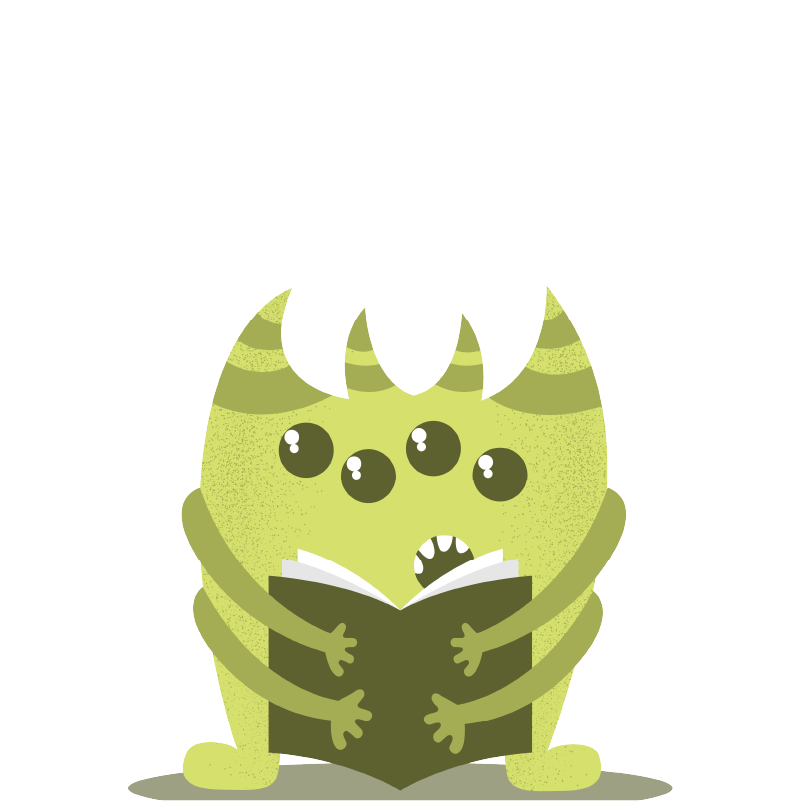English Language Arts
for 4th Grade Students
See what skills your child will learn in English Language Arts, examples of student work and how you can help at home.
Tip: Hover over icons to see definitions of key terms.
This is an example tooltip!

Expectations for Students
4th graders should understand how to do the following by the end of the year:
Applying Literacy Skills
Write complete sentences & paragraphs, with mostly correct spelling, capitalization, & punctuation including: commas, apostrophes, quotation marks, & end of sentence punctuation.
Overall, dogs are awesome pets to have. Have I convinced you though? If you are, then great! If you’re not then that’s okay. It’s really up to you. So which one is it going to be?
Read & understand diverse types of 4th grade-level texts (Lexile 740–1010, F&P: N–Z, DRA: 30-60) fluently & with expression at a fluency rate of around 90–140 words per minute.
Use technology (with some support if needed) to produce & publish writing & to work with others.
Type a minimum of one page in a single class period.
Learning About the World Through Text
Ask & answer questions about texts read on their own. Use specific evidence from the text to explain events & procedures, explain the main idea, connect ideas, & support inferences about the text.1
The book Charlotte’s Web by E. B. White is a story about an endearing pig named Wilbur. He is desperately trying not to die. He meets a nice friend named Charlotte. She is a spider that weaves words into her web to save Wilbur from dying. Charlotte was one of the most caring friends you could have for a long time. One way she was caring was when Wilbur was tired of being terrific all day. Charlotte sang him a lullaby. Another example is that she calmed Wilbur down when he was scared. Wilbur was devastated when he found out he was going to die and Charlotte said, “You shall not die I shall save you.”
Figure out the meaning of unknown words by using pictures, context, glossaries, etc. Figure out words with multiple meanings or figurative language
.
THE SKY IS LOW BY EMILY DICKINSON
The sky is low, the clouds are mean,
A travelling flake of snow
Across a barn or through a rut
Debates if it will go.
A narrow wind complains all day
How someone treated him;
Nature, like us, is sometimes caught
Without her diadem.
Use linking phrases to connect opinions & reasons. For example, use “in order to”, “for example”, etc.
Use transition phrases to show the order of events. For example, use “first,” “in addition”, etc.
Write about what happened or information learned from the text. Include a title, an introduction, well-developed examples, vocabulary that relates to a subject, & a conclusion.
Write creative stories about real or imagined experiences. Students should introduce a narrator or characters & organize events in a natural order. Stories should include conversation, character descriptions, sensory details, & a conclusion.
FINDING ROSALITA
It was Sunday. My family and I were in France. I was as happy as a bee. We were driving along the road when my daddy stopped the car. He told my brother and sister to get out of the car to see what the furry lump on the side of the road was. They got out of the car. Ten seconds later, they got back in the car with a very small kitten in their hands. She was about the size of a very, very, very, very small baby bottle.
My stomach went into my throat when I saw it actually was a kitten. She was meowing as loud as a foghorn. It was so horrible, I couldn’t think. Mreow. I felt horrible. I knew that I hadn’t done anything bad to her, but I just couldn’t help it. She was so cold. I was worried. Her claws were as sharp as sewing needles being pricked into your skin. I shuddered. She had crusts over her eyes, from infections, that looked like they hurt.
We were headed into the village. Madame Sanz was there. We asked her what to do. I was afraid that she wouldn’t have any advice. Thankfully, she told us what to do. She told us to boil rose petals in water till they were warm and wet. Then we should pour them into a bowl with some water and keep on rubbing then over the kitten’s eyes.
After that, we decided to call the little kitten Rosalita. We also call her other things that sound like Rosalita, but I won’t mention that. We prayed. Luckily, she is still with us now. Hopefully, she will be with us much, much, much, much longer.
1 Writing sample obtained with permission from Student Partners. “Student Writing Samples.” Achieve the Core.
Example Student Work
Sidebar Tooltip
“The Seedling” By Paul Laurence Dunbar
1
As a quiet little seedling
Lay within its darksome bed,
To itself it fell a-talking,
And this is what it said:
5
“I am not so very robust,
But I’ll do the best I can;”
And the seedling from that moment
Its work of life began.
So it pushed a little leaflet
Up into the light of day,
10
To examine the surroundings
And show the rest the way.
The leaflet liked the prospect,
So it called its brother, Stem;
15
Then two other leaflets heard it,
And quickly followed them.
To be sure, the haste & hurry
Made the seedling sweat & pant;
But almost before it knew it
20
It found itself a plant.
The sunshine poured upon it,
And the clouds they gave a shower;
And the little plant kept growing
Till it found itself a flower.
25
Little folks, be like the seedling,
Always do the best you can;
Every child must share life’s labor
Just as well as every man.
And the sun & showers will help you
30
Through the lonesome, struggling hours,
Till you raise to light & beauty
Virtue’s fair, unfading flowers
Example Tooltip
Introduces main characters
Uses a variety of transition words &
phrases to manage the sequence of events
Establishes a situation
Uses end of sentence punctuation accurately
Uses concrete words & phrases & sensory details to convey events correctly
The Haunted House
There once was a dog who roamed an alley with another dog. That dog’s name was Max. The other dog’s name was Rocky. Max & Rockey were brother & sister, although the look nothing alike . In another alley not far from Max & Rocky’s there was a dog & a cat who lived together in that alley. The dog’s name was Surgar & the cat’s name was shantell. One day they all met behind a trachcan & became best buds.
One day while all the friends were out walking in the street & then Shantell(thecat) spotted a ghost flying around in a house & took off running to go see the ghost. Then all the dogs took off afterer her. When the dogs finaly cought up to Shantell they were all deep in the huanted house. Max & Surgar started to shake. Rocky & Shantell started to quake. Then a loud Boom came from the floor above them. After, Max got a brillent idea. They should sneak up on the monsters & attack them .
Finally all four animals were ready to put their maniecle plan into action. Shantell tip-toed up the mantel while Max & Surgar went up the back stairs. Which left Rockey creeping up the front stairs. When they all were ready to attack the monsters they heard music. The went alot like this “Shake, Shake shake dem bones now!” The friends were confused but quickly got back on track. Shantell gave the ready signal & they all jumped up.
They were surprized to see what they saw. They saw about a dozen monsters doing the monster mash. One of the vampires said “Come in dogs & cats. Why don’t you dance with us. So Max, Rocky, Surgar & Shantell danced with the monsters.”
Uses concrete words & phrases & sensory details to convey events correctly
Uses dialogue & description of actions, thoughts, & feelings to develop events & show the response of characters to situations
Everyday Activities to Support Learning
Tips for Talking to Teachers
A strong relationship between families and teachers is key to ensuring students have what they need to succeed. Parent involvement not only leads to higher grades and test scores, but also helps students develop self-confidence, motivation, and social skills. Knowing what questions to ask at school visits and parent-teacher conferences can help you feel confident when it comes to addressing your child’s’ academic needs.

